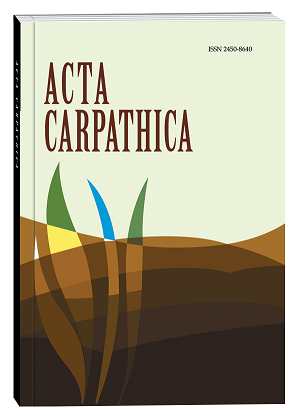EFFICIENCY OF USING BIOPREPARATIONS IN GROWING LENS CULINARIS MEDIKUS
DOI:
https://doi.org/10.32782/2450-8640.2023.2.8Keywords:
food lentil, plant growth regulators, growth, symbiotic system, yield.Abstract
The purpose of the study was to evaluate the effectiveness of presowing treatment of Lens Culinaris Medikus seeds of the Linza variety with plant growth regulators, Regoplant and Stympo, based on plant growth parameters, formation of symbiotic systems on the roots, and seed yield. A field experiment was conducted on the territory of the agrobiolaboratory of Volodymyr Hnatiuk Ternopil National Pedagogical University from 2019 to 2022. Plants were grown using a common technology for the Forest-Steppe region of Ukraine. The seeds were moistened with water at a rate of 2% of their mass before sowing (control) and with plant growth regulators Regoplant (25 ml/l) and Stympo (2,5 ml/l). The variants were arranged in a single-row sequence with four replications and an accounting area of 4 m2. Data underwent descriptive and correlation (P ≤ 0,05) analysis. It was established that the use of plant growth regulators stimulated growth processes and increased the seed productivity of plants. The plant growth regulator Stympo was more effective, increasing the height of shoots during the budding, flowering, and green pod phases by 19,6, 27,6, and 21,1% compared to the control. Additionally, it increased the quantity and weight of fresh nodules on the roots of plants by 47,3 and 50,5% during the flowering phase, and by 5,9 and 18,2% in terms of the weight of 1 000 seeds and seed yield. Therefore, plant growth regulators Regoplant and Stympo at the specified doses can be effectively used in the technology of growing food lentils in the Western Forest-Steppe of Ukraine to increase its productivity.
References
Anjali Yadav, Arvind M. Kayastha. Lens culinaris β-galactosidase (Lsbgal): Insights into its purification, biochemical characterization and trisaccharides synthesis. Bioorganic Chemistry. 2020. № 95. Р. 103. DOI: 10.1016/j.bioorg.2019. 103543.
Mircea Oroian. The temperature hydration kinetics of Lens culinaris. Journal of the Saudi Society of Agricultural Sciences. 2017. № 16 (3). Р. 250–256. DOI: 10.1016/j.jssas.2015.08.004.
Isolation of antioxidant phytoconstituents from the seeds of Lens culinaris Medik. / Mohammad Jameel et al. Food Chemistry. 2015. № 175. Р. 358–365. DOI: 10.1016/j.foodchem. 2014.11.130.
Can lentil (Lens culinaris Medikus) reduce the risk of obesity / Niroshan Siva et al. Journal of functional foods. 2017. № 38. Р. 706–715. DOI: 10.1016/j.jff.2017.02.017.
Effect of herbicide stress on synchronization of carbon and nitrogen metabolism in lentil (Lens culinaris Medik.) / Shivani Satvir Kaur Grewal et al. Plant Physiology and Biochemistry. 2023. № 196. P. 402–414. https://doi.org/10.1016/j.cropro.2023.106438.
Comparative effects of caffeine and lead nitrate on the bio-physiological and yield associated traits of lentil (Lens culinaris Medik.) / Janib Yousuf et al. Heliyon. 2023. № 9 (6). P. 16351. https://doi.org/10.1016/j.heliyon.2023.e16351.
Nutritional, chemical and antioxidant evaluation of Armuña lentil (Lens culinaris spp): Influence of season and soil / Ângela Liberal et al. Food Chemistry. 2023. № 411. Р. 13549. https://doi.org/10.1016/j.foodchem.2023.135491.
Kripi Vohraa, Vivek Kumar Gupta. Pharmacognostic evaluation of Lens culinaris Medikus seeds. Asian Pacific Journal of Tropical Biomedicine. 2012. № 2. Р. 1221–1226. DOI: 10.1016/S2221-1691(12)60389-X.
Лавренко С.О., Максимов М.В. Фотосинтетичний потенціал посівів сочевиці залежно від технологічних прийомів вирощування. Збірник наукових праць Уманського національного університету садівництва. 2016. № 89. С. 185–191.
Sarker A., Singh M. Improving breeding efficiency through application of appropriate experimental designs and analysis models: A case of lentil (Lens culinaris Medikus subsp. culinaris) yield trials. Field Crops Research. 2015. № 179. P. 26–34. DOI: 10.1016/j.fcr.2015.04.007.
Use of iso-osmotic solution to understand salt stress responses in lentil (Lens culinaris Medik.) / M.S. Hossain et al. South African Journal of Botany. 2017. № 113. Р. 346–354. DOI: 10.1016/j.sajb.2017.09.007.
The roles and potential of lentil prebiotic carbohydrates in human and plant health / Nathan Johnson et al. Plants, People, Planet. 2020. № 2. Р. 310–319. DOI: 10.1002/ppp3.10103.
Reprint of “Bioaccessibility, in vitro antioxidant and anti-inflammatory activities of phenolics in cooked green lentil (Lens culinaris)” / Bing Zhang et al. Journal of Functional Foods. 2017. № 38. Р. 698–705. DOI: 10.1016/j.jff.2017.03.040.
Chemopreventive effect of raw and cooked lentils (Lens culinaris L.) and soybeans (Glycine max) against azoxymethane-induced aberrant crypt foci / Mo’ez Al-Islam E. et al. Nutrition Research. 2009. № 29 (5) Р. 355–362. DOI: 10.1016/j.nutres.2009.05.005.
Mo’ez Al-Islam E. Faris, Mohammad G. Mohammad, Sameh Soliman Lentils (Lens culinaris L.) а candidate chemopreventive and antitumor functional food. Functional Foods in Cancer Prevention and Therapy. 2020. № 6. Р. 99–120. DOI: 10.1016/B978-0-
-816151-7.00006-5.
The clinical utility of Lens culinaris agglutinin-reactive thyroglobulin ratio in serum for distinguishing benign from malignant conditions of the thyroid / K. Shimizu et al. Clinica Chimica Acta. 2007. № 379 (1–2). Р. 101–104. DOI: 10.1016/j.cca.2006.12.017.
Сочевиця у світі та Україні: сучасний стан і перспективи / В. Січкар та ін. Journal of
Native and Alien Plant Studies. 2020. № 16. С. 178–193. DOI: 10.37555/2707-3114.16.2020.219830.
Максимов М.В. Удосконалення технології вирощування сочевиці за різних умов зволоження : дис. … канд. с.-г. наук : 06.01.02. Херсон, 2016. 206 с.
Сочевиця – джерело рослинного білка / В.Д. Орехівський та ін. Зернові продукти і комбікорми. 2017. Т. 17. № 4. С. 22‒29.
A feature collection of lentil (Lens culinaris Medik.) by nutritious value of seeds / N.A. Vus et al. Plant Breeding and Seed Production. 2020. № 117. Р. 25–36. DOI: 10.30835/2413-7510. 2020.206962.
Регулятори росту рослин. Рекомендації по застосуванню / Л.А. Анішин та ін. Київ : МНТЦ «Агробіотех», 2011. 54 с.
Методи біологічних та агрохімічних досліджень рослин і ґрунту / З.М. Грицаєнко та ін. Київ : ЗАТ «Нічлава», 2003. 320 с.
New plant growth regulators: basic research and technologies of application : monograph / Ed. S.P. Ponomarenko, H.O. Iutynska. Kyiv : Nichlava, 2010. 211 p.
Формування симбіотичного апарату сочевиці за дії біологічних препаратів / В.П. Карпенко та ін. Вісник Уманського національного університету садівництва. 2018. № 2. С. 39–44. DOI: 10.31395/2310-0478-2018-21-39-43.
Вміст пігментів у листках сочевиці за дії біологічних препаратів / В.П. Карпенко та ін. Наукові горизонти. 2019. № 7. С. 41–47. DOI: 10.33249/2663-2144-2019-80-7-41-47.
Новікова Т.П. Фотосинтетична продуктивність рослин сочевиці за дії біологічних препаратів. Наукові горизонти. 2019. № 10 (83). С. 28–34. DOI: 10.33249/2663-2144-2019-83-10-28-34.








